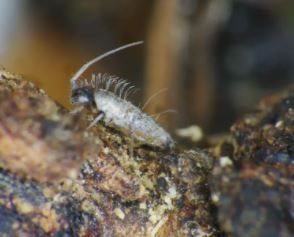Although soils are vital for agriculture, biodiversity and clean water, this below-ground world is often overlooked. The loss of life below the ground due to intensification of agriculture, climate change, erosion and compaction, among other things, is one of the biggest global threats to soils.
Many organisms live in the soil. In fact, about 25% of all biodiversity occur in the soil. These organisms don’t function in isolation, but interact with each other and the above-ground world in complex ways. They provide essential services and benefits such as the breakdown of leaf litter for nutrient cycling, play a role in the formation of soil structure, and clean water and air through the soil layers.
With an increase in extreme events such as heatwaves and droughts due to climate change, soil is becoming increasingly degraded worldwide. Organisms and the soils they live in are dying. Another reason is the increased demand for food production through more intensive agriculture, and compaction – when soil particles are pressed together, reducing the space between soil particles – reduces water infiltration and air in the soil.
But if there’s a change in how soils are managed, more resilient and sustainable soils can be created that can survive these increasing extreme events and enhance food security. This means soil will recover after extreme events. It won’t need so many fertilisers and pesticides, and will be able to maintain long-term production of high quality food.
The theme for this year’s World Soil Day on 5 December is: “Keep soil alive, protect soil biodiversity.” It coincides with the release of the State of Knowledge of Soil Biodiversity report. This report, facilitated by the Food and Agriculture Organisation of the United Nations (FAO), involved more than 300 scientists from around the globe, myself included. It highlights the rich diversity of soil organisms under our feet that drive processes that produce food and purify soil and water.
Soil biodiversity in Africa
 |
Soils are the most biologically diverse habitat on earth. One gram of soil contains several thousands of different species. More than 40% of all land organisms have their life cycle, or part of it, in the soil. These range from the smallest microbes, fungi and nematodes, to mites, springtails, centipedes, millipedes, potworms, various insects such as ants and termites, larger arthropods such as millipedes, spiders and woodlice, and even larger vertebrates such as moles and reptiles.
Over the past few decades there’s been a increased interest in soil health globally and in South Africa. This comes after events such as massive droughts, erosion and studies of the function that soil organisms play in soil health and increased awareness campaigns.
Read more: Dust in the atmosphere is a sign of trouble in South Africa’s maize fields
Despite South Africa being only 0.8% of the earth’s terrestrial area, it contains nearly 1.8% of the world’s described soil species. South African soils contain a very high number of species that occur nowhere else in the world, especially nematodes and earthworms, although these are groups that have been studied more than others.
Knowledge of soil biota in South Africa such as spiders, ants, termites and mites is increasing, while other groups such as diplurans and springtails (tiny wingless invertebrates) are understudied. Their small size may be a reason that they’re often overlooked, but the identification of these small animals is also difficult. The expert skills needed to identify them is limited.
 |
But with increased international collaborations, more is being learnt about these overlooked underworld labourers. Springtails have been increasingly studied because they’re good indicators for soil health. They respond quickly to changes in the environment and are sensitive to change. They mostly feed on decaying plant material, bacteria and fungi, so they play an important role in the decomposition process.
Many new species have been discovered in South Africa, but their functional roles in natural and even in “simple” agro-ecosystems are only now being investigated.
Threats and challenges
Large parts of African soils are severely degraded, while several million tons are lost to soil erosion every year.
Several human activities have been identified in the State of Knowledge of Soil Biodiversity Report as major threats to soil biodiversity and function in Africa. These include deforestation, agricultural intensification, loss of soil organic matter and soil organic carbon, climate change, fire, soil compaction and sealing, salinisation, erosion and invasive species. In addition, knowledge of the impacts of these threats is lacking and this may hamper sufficient management to conserve this below-ground system.
Why soil biodiversity matters
Soil biodiversity contributes to healthy soils, provides many ecosystem services and in turn achieves compliance with (among others) the following Sustainable Development Goals:
• Food production: The link between soil and food is very clear. Food security in Africa is amajor challenge. Crop quality and yield is directly linked to soil health.
• Water quality: Soil biota play an important role in regulating the movement of water into and through the soil as well as cycling of nutrients in the soil and water. Poor soil quality can increase the risk of nutrients being lost via leaching and water runoff, which can lead to groundwater contamination.
• Air quality: increased tillage can increase the production of carbon dioxide by microbes that can contribute to global warming. Certain soil microbes can release methane from soil or transform nitrate into the greenhouse gas nitrous oxide. On the other hand, soil microbes and soil fauna can improve soil structure and reduce the risk of wind erosion.
• Climate change mitigation: as agricultural soils cover such a large part of the globe, agricultural practices such as reducing tillage and increasing plant cover can improve soil biological activity and carbon sequestration.
One step in the right direction is to raise awareness about the importance of soil biodiversity and practise conservation farming, that is to use minimum or no-tillage, to have a crop rotation system and permanent soil cover (thus residue is left after harvesting).
Foundational knowledge of soil biodiversity is needed in Africa, especially if applied soil research is to be effective in ensuring resilient soil. For South Africa this means more integrative research, training more taxonomists to describe the large number of unknown species, and funding to acquire knowledge of the soil biodiversity in this mega-diverse region.
This article is republished from The Conversation under a Creative Commons license. Read the original article.



